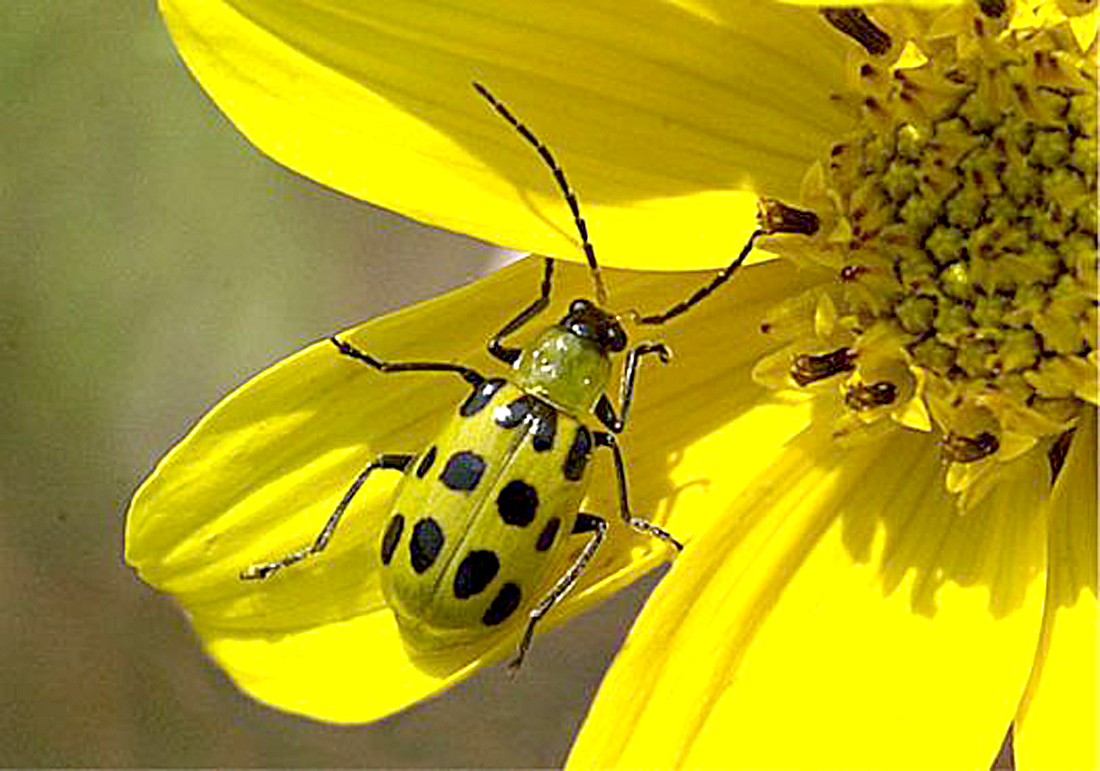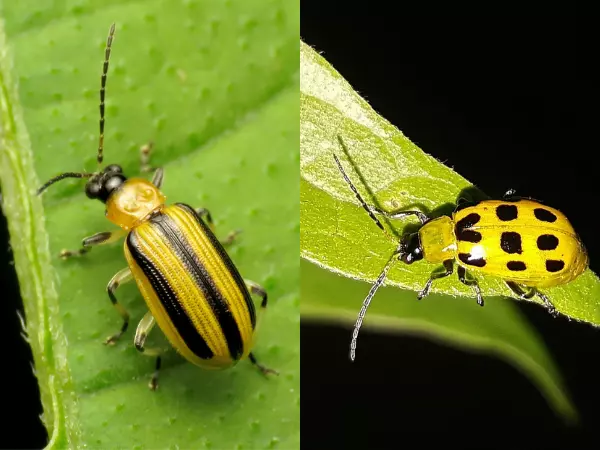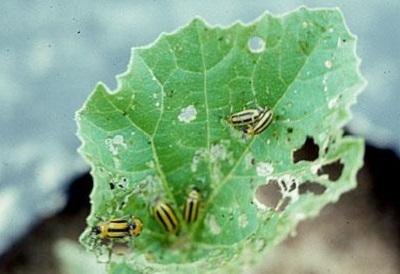Cucumbers are a beloved staple in many home gardens, prized for their crisp bite, cool flavor, and adaptability in dishes ranging from salads to pickles and snacks. Yet, growing cucumbers comes with its own set of hurdles, particularly pest problems. These unwelcome visitors can harm leaves, stems, flowers, and fruits, leading to lower yields or even plant death if ignored. Fortunately, by spotting issues early, taking preventive steps, and using natural pest control methods, gardeners can safeguard their cucumber crops and enjoy a plentiful harvest. This guide highlights the five most frequent pests that threaten cucumbers and offers practical advice on how to keep them at bay.
1. Cucumber Beetles

Why They’re Harmful
Cucumber beetles are small insects, either striped or spotted, that munch on leaves, flowers, and fruits. They pose a serious threat because they can spread bacterial wilt, a devastating disease that causes leaves to droop and plants to perish.
Signs You Might See
- Leaves and flowers with bite marks
- Yellowing or drooping foliage
- Small beetles visible, often yellow-green with black stripes or spotted patterns
How to Prevent and Manage
- Use row covers: Shield young plants with lightweight fabric until flowering begins.
- Handpick beetles: Remove them by hand if infestations are minor.
- Employ trap crops: Grow radishes or nasturtiums nearby to lure beetles away from cucumbers.
- Spray neem oil: This natural remedy deters beetles while protecting beneficial insects.
2. Aphids

Why They’re Harmful
Aphids are tiny, soft-bodied bugs that suck sap from plants, weakening cucumbers and causing leaves to curl and fruits to suffer in quality. They also produce sticky honeydew, which can encourage fungal diseases.
Signs You Might See
- Leaves curling, yellowing, or stunted growth
- Sticky residue on leaves and stems
- Clusters of small green, black, or red aphids on the undersides of leaves
How to Prevent and Manage
- Attract natural predators: Ladybugs, lacewings, and parasitic wasps feed on aphids.
- Companion planting: Grow garlic, chives, or marigolds nearby to repel aphids.
- Use soap sprays: Mix mild liquid soap with water and spray affected areas.
- Blast with water: A strong spray can knock aphids off leaves.
3. Spider Mites
Why They’re Harmful
Spider mites are tiny arachnids that feed on the undersides of leaves, causing speckled discoloration, yellowing, and fine webbing. They thrive in hot, dry environments and can multiply quickly if not controlled.
Signs You Might See
- Tiny yellow or white spots on leaves
- Fine webs on leaves and stems
- Leaves turning bronze or dropping prematurely
How to Prevent and Manage
- Increase humidity: Mist plants or use drip irrigation to reduce dry conditions that favor mites.
- Inspect regularly: Check leaf undersides weekly for early signs.
- Apply insecticidal soap or neem oil: Thoroughly spray affected areas.
- Remove heavily infested leaves: Dispose of them away from your garden to prevent spread.
Squash Bugs
Why They’re a Concern
Squash bugs are sizable, brown insects that drain sap from cucumber leaves and stems, leading to wilting and yellowing patches. Their feeding can drastically hinder plant development and slash crop yields.
Indicators of Infestation
- Yellow spots on leaves that gradually darken to brown
- Plants wilting even when adequately watered
- Sightings of dark, shield-shaped bugs along with clusters of bronze-colored eggs
Methods for Prevention and Management
- Manual Removal: Regularly pick off adult bugs and eggs by hand.
- Row Covers: Shield young plants with covers until flowering begins.
- Debris Cleanup: Eliminate fallen leaves and plant debris to minimize hiding places.
- Neem Oil Application: Use neem oil cautiously as a natural repellent.
Whiteflies
Why They’re a Concern
Whiteflies are tiny, white-winged insects that feed on the undersides of cucumber leaves. They weaken plants, cause leaf yellowing, and can spread viral diseases.
Indicators of Infestation
- Small white insects that flutter up when leaves are disturbed
- Leaves turning yellow or curling
- Sticky honeydew deposits on leaves, which encourage sooty mold growth
Methods for Prevention and Management
- Sticky Traps: Use yellow sticky cards to attract and capture adult whiteflies.
- Natural Predators: Introduce beneficial insects like lacewing larvae or ladybugs to prey on whiteflies.
- Neem Oil Spray: Apply to reduce whitefly numbers and prevent egg-laying.
- Reflective Mulches: Silver or reflective plastic mulches can deter adult whiteflies.
General Tips for Avoiding Cucumber Pests
- Crop Rotation: Change planting locations yearly to prevent pest buildup.
- Healthy Seedlings: Start with vigorous, disease-free plants.
- Proper Spacing: Ensure good airflow to lower humidity and discourage pests.
- Watering Techniques: Water at the base to keep leaves dry and less attractive to pests.
- Regular Inspections: Early detection allows prompt action before infestations spread.
- Companion Planting: Use herbs like basil and dill, and flowers such as marigolds, to attract beneficial insects and repel pests.
- Tool Hygiene: Sterilize garden tools and containers to prevent disease and pest transmission.
Conclusion
While cucumber pests can be challenging, understanding their behavior and vulnerabilities empowers gardeners to manage them naturally. Employing strategies like companion planting, fostering beneficial insects, maintaining plant health, using physical barriers, and applying natural treatments helps keep cucumbers thriving without harmful chemicals. This approach not only ensures a plentiful harvest but also supports a sustainable, eco-friendly garden environment. With consistent care and vigilance, cucumber pests can be effectively controlled, allowing your garden to flourish year after year.
- Cucumbers in Gardens: Valued for crisp texture, refreshing taste, and versatility in salads, pickles, and snacks.
- Pest Challenges: Common pests damage leaves, stems, flowers, and fruits, reducing yield or killing plants.
- Management Approach: Early detection, prevention, and natural control ensure healthy plants and good harvests.
1. Cucumber Beetles
- Feed on leaves, flowers, fruits; transmit bacterial wilt causing plant death.
- Signs: Chewed foliage, yellowing, wilting, visible striped/spotted beetles.
- Controls: Row covers, handpicking, trap crops (radishes, nasturtiums), neem oil spray.
2. Aphids
- Sap feeders causing leaf distortion, reduced fruit quality, and sticky honeydew leading to fungal growth.
- Signs: Curling, yellowing leaves, sticky residue, clusters of tiny insects.
- Controls: Encourage predators (ladybugs, lacewings), companion plants (garlic, chives, marigolds), soap or water sprays.
3. Spider Mites
- Tiny arachnids causing stippling, yellowing, webbing; thrive in hot, dry conditions.
- Signs: Yellow/white leaf spots, fine webbing, bronze leaves, leaf drop.
- Controls: Maintain humidity, inspect leaves, insecticidal soap or neem oil, remove infested leaves.
4. Squash Bugs
- Large insects sucking sap causing wilting, yellow/brown spots, stunted growth.
- Signs: Yellow/brown leaf spots, wilting, dark shield-shaped bugs and bronze eggs.
- Controls: Handpicking adults and eggs, row covers, debris removal, neem oil.
5. Whiteflies
- Tiny white flying insects feeding on leaf undersides, causing yellowing and viral disease transmission.
- Signs: White insects flying when disturbed, yellowing/curling leaves, sticky honeydew with sooty mold.
- Controls: Sticky traps, natural predators (lacewing larvae, ladybugs), neem oil, reflective mulches.
General Prevention Tips:
- Rotate crops annually to reduce pests.
- Use healthy, disease-free seedlings.
- Space plants for good airflow.
- Water at plant base to keep foliage dry.
- Inspect regularly for early pest detection.
- Use companion planting to attract beneficial insects and repel pests.
- Clean garden tools to prevent disease spread.
Conclusion:
- Understanding pest habits enables natural prevention and control.
- Use companion planting, beneficial insects, physical barriers, and natural sprays.
- Natural pest management supports healthy, sustainable gardens and bountiful harvests.
- Vigilance and consistent care ensure thriving cucumber plants season after season.
